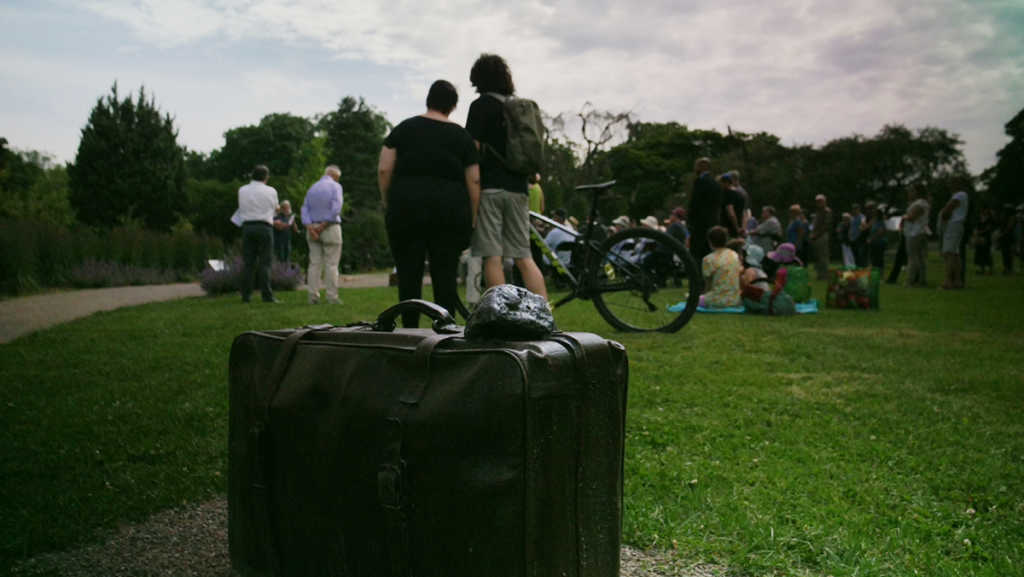A guest contribution by Richard Ames, Stoney Creek, ON
“So much death. What can men do against such reckless hate?”
-King Theodan, The Two Towers
On Friday, in Churchill Park in Hamilton, many gathered at the invitation of the Hamilton Jewish Federation & Margaret’s Legacy, including students from the Hamilton Hebrew Academy, to celebrate the newly installed monument, “Be:longings” in honour and memory of Raoul Wallenberg. I was overwhelmed and struck by the experience.
It is to my embarrassment – as it is perhaps to many others – that before today, Wallenberg’s was just a name on a page that, at best, I had come across in my studies of the Second World War and the Holocaust… but nothing more.
My education of the Holocaust began in 1994 in Grade Seven. If you know what was happening in the culture around the date, you can imagine why a white, anglo-saxon, Protestant would suddenly be paying attention.
In December of 1993, Schindler’s List debuted in theatres and would soon go on to win Best Picture at the 1994 Academy Awards. It also propelled the associated 1982 book, Schindler’s Ark (subsequently renamed Schindler’s List), back into cultural awareness, which we hastily shared from one student to the next as our parents were decidedly cautious about allowing us to see the film. Despite its historical significance, the horrific glimpses into the ghettos and concentration camps that the film recreated were feared to be too much for us. But they couldn’t hold back the tide, as we could hardly believe that such atrocities had been committed on such a scale during our Grandparent’s lifetimes and desired to know more and try to understand.
Soon we were reading more books on the subject, writing reports on it, submitting speeches about it, and so, whatever feelings people may have about the film – for good or ill – and its depiction of the Holocaust and the glimmers of hope that shone in the darkness… it at least got us talking and learning about it in earnest.
But like so many things in life, all that learning faded into the background. Not forgotten – never forgotten, for who could forget such things?! – but muted. Compartmentalized and kept at a safe distance, only to occasionally be thrust back into consciousness, forcing you to once again confront ‘so much death’ and ‘such reckless hate’.
Today however, I was reminded not only of the horror, atrocities, and injustices exacted on the Jewish people through the Holocaust. Not only of the glimmers of hope in such dark times. But how little time it takes to hear someone’s story and be deeply moved by its significance.
In only an hour this morning I went on a journey from near-total ignorance of Raoul Wallenberg and his efforts to awe-struck amazement as I learned that he helped rescue, not 1,200 Jews as Schindler had, but tens of thousands!
For those that don’t know as I didn’t, while serving as Sweden’s special envoy in Budapest between July and December 1944, Wallenberg issued protective passports and sheltered Jews in buildings which he declared as Swedish territory. As the grandson of a woman saved by Wallenberg said at this morning’s event, that the Nazis “went along with this” is a testament to his ingenuity and cunning.
In the six months he spent in Budapest, he helped save thousands of Jews from persecution, more than any individual, organization or government. It leaves one speechless. But it also answers the question posed by King Theodan:
this is what men can do against such reckless hate.
It was costly though.
As we heard through testimony by Hamilton resident, Ernie Mason, who was personally rescued as a young child by Wallenberg, the toll was high. They were forced to leave behind everything and quickly be ushered into hiding with only a suitcase as their belongings, which this monument so powerfully captures. And then being displaced to a new home. To say nothing of the trauma these events would leave in the decades since.
The cost to Wallenberg would ultimately be high as well, as I learned with sorrow that on the 17th January 1945, during the Siege of Budapest by the Red Army as they were to finally be ‘liberated’, Wallenberg was arrested on suspicion of espionage. He was subsequently disappeared, never to be seen again. An unjust and tragic end to a truly heroic person.
That it would take years for the world to recognize and honour his heroism and compassion is, sadly, unsurprising. Heroism is often not recognized in its own time, especially when the hero in question looks like just another ordinary man or woman.
But Wallenberg’s deeds were far from ordinary. And his name was eventually given its due as many countries made him an honourary citizen, including Canada in 1985 as the nation’s very first person to receive such a title and Raoul Wallenberg Day is celebrated on January 17.
Unfortunately, all these larger gestures do not mean the average Canadian is any more aware of him now, as I wasn’t. Instead it took an hour out of my usual routine to stop, listen, learn, reflect, and truly become not only aware but deeply impacted by someone’s story, not just facts on a page. And now his is a name which I will now not only remember, but be unable to forget. Storytelling has that effect, which is why my hope is that as people walk the grounds of Churhill park they will experience something of the revelation I had.
I wish to thank the City of Hamilton, artists Gary Barwin, Simon Frank, and Tor-Lukasik-Foss, and the Hamilton Jewish Federation for commissioning and creating this monument.
May we never forget the lives lost, those who survived, the sacrifices made, and the lessons learned.

